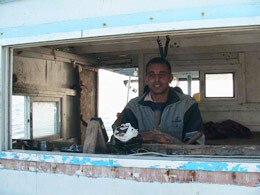Palestinian Center for Human Rights 7 November 2008

Saber al-Hissie’s 20-meter boat is scarred with bullet holes from the Israeli military, who harass the fishermen daily. (PCHR)
Saber al-Hissie comes from a Gazan family of fishermen. His 20-meter vessel belongs to his father, who, after many years of fishing, has finally passed the family business over to Saber. There are more than 3,500 professional fishermen in the Gaza Strip, and the majority of them live in and around Gaza City, where the main harbor is located. The al-Hissie family live in the sprawling refugee camp, known locally as the Beach camp, near the Gaza harbor.
The Gaza harbor awakens before dawn. The fishermen land the night catch, the fishmongers gather to buy the fish, and those fishermen who have spent the night in the luxury of their own beds at home arrive to start preparing for the early morning fishing. Nets are mended, fuel and water supplies replenished, and the boats are back out at sea before 7am. Saber al-Hissie has a crew of seven men and boys with him today, including 13-year-old Mahmoud, and 18-year-old Ali, who both regularly work as fishermen. Mahmoud is still at school, but Ali says he never went to school. “I always wanted to be a fisherman” he says, grinning.
As we sail out of the harbor and head west, Saber al-Hissie describes the restrictions that Israel is imposing on him and every other fisherman trying to earn a living in the Gaza Strip. “If we sail six miles out to sea, then maybe we will be safe” he says. “But if we go any further out to sea, the Israelis always harass us. They circle the boats, they shoot towards us, and recently they started using water cannons to attack us.” He explains that some fishermen still take the risk of sailing past than the six-mile limit, where they can trawl for the richer stocks of fish in deeper waters. “But I don’t want my boat damaged so I stay within the [Israeli] limit” he adds. His boat is already scarred with bullet holes inflicted by the Israeli Occupation Forces (IOF).
The fishermen often sail out of the Gaza harbor in fleets. Some vessels stay fairly close together at the edge of the six-mile limit for mutual protection, though a minority of fishermen sail on further, in defiance of the IOF. But regardless of how far they sail, all the fishermen risk being shot, sprayed by water cannons, arrested and detained, and also having their vessels damaged, destroyed or confiscated. More than 70 Gaza fishermen were arrested by the IOF last year.
Commercial fishing is an inherently risky profession, and has become increasingly more dangerous in Gaza because of the relentless IOF harassment and intimidation. Even before we reach six miles from the Gaza coast, we can see three Israeli gunboats speeding towards us. We are amongst a fleet of around ten Gazan fishing vessels that gradually disperse between six to eight miles from the coastline and drop their nets. The crew on board Saber’s boat become visibly tense as the Israeli gunboats begin circling individual vessels at high speed, causing huge waves that pitch the vessels. Soon we can clearly see fishing vessels being water cannoned by one of the Israeli gunboats. “The Israelis attack us every day” says one of the crew, Abu Mahmoud. “Until you see it for yourself, you cannot believe the situation we are facing.”
Gazan fishermen say the Israelis are using dirty, possibly contaminated water in the high-speed water cannons, in order to force them back towards shore, despite the fact the fishermen have the absolute right to fish off their own coast. The Interim Arrangements signed between the PLO and Israel in 1994/1995, stipulate that Gazan fishermen have the legal right to fish up to 20 nautical miles from the Gaza coastline. However, Israel has never honored the Interim Agreements, and has consistently harassed and intimidated fishermen across the Gaza Strip, decimating the local fishing industry.
Ten years ago, Gazan fishermen were hauling approximately 3,000 tons of fresh fish a year. But productivity has plummeted since the second intifada due to escalating IOF attacks, and now the fishermen are hauling less than 500 tons of fresh fish per year and being forced to over-fish the shallow waters in close proximity to Gaza. The fishermen say the presence of a small group of international human rights observers from the Free Gaza Movement has improved the situation for those boats which are accompanied by the internationals, but these fishermen want their right to work without facing daily harassment and violence from the IOF. This manufactured crisis in the Gaza fishing industry is yet another part of the overall IOF siege and closure of Gaza, including its mass violations of the social and economic rights of the entire civilian population of the Gaza Strip.
One of the Israeli gunboats speeds towards us, and uses a megaphone to order us back. We are now at the edge of the six-mile limit, and Saber refuses to be cowed. His crew calmly continues working, as the gunboat circles us at high speed and the boat pitches wildly. When the IOF start to shoot into the waters around us with a sub-machine gun, Saber turns his vessel back towards Gaza. “We just want to fish and support our families” he says. “We are not committing any crimes. But they are.”
This report is part of the Palestinian Centre for Human Rights’ Narratives Under Siege series.
Related Links